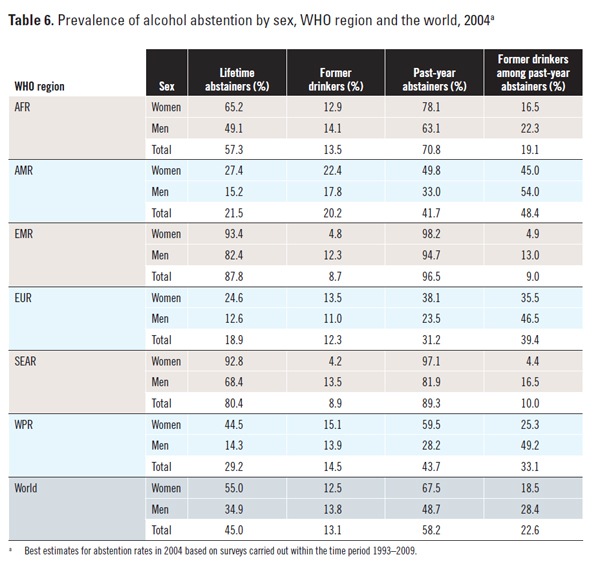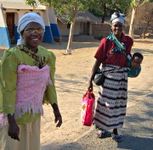Half the world’s adults do not drink alcohol – what should the policy implications be?
Non-drinkers make up nearly half the world’s adult population. A paper presented at the GAPC conference in Seoul suggests what the policy implications of this may be, in particular for developing countries which have remarkable high segments of non-drinkers in their populations.
 Close to half of the world’s adult population – 45 per cent - is life-time abstainers. The proportion on non-drinkers increases to 58 per cent if those who have not been drinking alcohol the last twelve months are included. These figures are best estimates for abstention rates based on surveys carried out within the time period 1993 – 2009. See more data in the table to the right, taken from the Global Status Report on Alcohol and Health, publishe by WHO in 2011.
Close to half of the world’s adult population – 45 per cent - is life-time abstainers. The proportion on non-drinkers increases to 58 per cent if those who have not been drinking alcohol the last twelve months are included. These figures are best estimates for abstention rates based on surveys carried out within the time period 1993 – 2009. See more data in the table to the right, taken from the Global Status Report on Alcohol and Health, publishe by WHO in 2011.
The paper on non-drinkers, which has been written by FORUT staff Øystein Bakke and Dag Endal, points to the fact that high rates of non-drinkers contribute significantly to a relatively low per capita consumption in many countries in Asia and Africa. This, in turn, reduces the level of alcohol-related harm. Based on development concerns as well as health, social and cultural considerations maintaining a high proportion of non-drinkers should be a strategic objective for national alcohol policies in the global South, conclude Bakke and Endal.
An overlooked fact?
The WHO global alcohol strategy has a guiding principle that “Children, teenagers and adults who choose not to drink alcohol beverages have the right to be supported in their non-drinking behaviour and protected from pressures to drink”. However, the paper by Bakke and Endal concludes that non-drinking segments of the population seem to be overlooked when national alcohol policies and strategies are designed, particularly where the alcohol industry is involved. But the large non-drinking populations in Africa and Asia are not ignored by the multinational alcohol corporations. They see enormous potentials in young non-drinkers becoming new and brand-loyal drinkers.
Regional differences
The figures on non-drinkers show interesting differences between various regions of the world. WHO Eastern Mediterranean Regional (EMRO), consisting of the Muslim countries in the Middle East and North Africa, is by far the lowest alcohol consuming region in the world, both in terms of total adult per capita consumption (APC) of 0.65 litres and prevalence of non-drinkers, i.e. 87.8% lifetime abstainers.
The WHO South East Asia Region (SEARO) follows with the second lowest APC of 2.2 litres and 80.4% lifetime abstainers. The third region is the African region (AFRO) where the APC is at 6.15 and 57.2% of the population are lifetime abstainers.
The Western world is at the other end of the scale with an abstention rate of 31.2 per cent in Europe and 41.7 per cent in the Americas, a figure which covers both North America and Latin America [1]. Figure 1 illustrates regional differences in the prevalence of abstention from alcohol.
Gender differences
The gender differences are another striking feature in the material on drinking patterns. Worldwide 48.7 per cent of men were past-year abstainers while 67.5 per cent of women did not drink last year. The differences between men and women are largest in the Western Pacific region and smallest in the Eastern Mediterranean region where there are practically no differences at all between the sexes.
Rather large differences are also found between individual countries within many of the regions. Studies of 20 African countries have shown that non-drinking rates varied between 41 and 89 per cent. Data in a study by Clausen, T. et al stem from the WHO World Health Survey collected in 20 African countries between 2002 and 2004. Close to nine out of ten adults in Tunisia and Swaziland are life-time abstainers, compared to 40 per cent in Mauritius and around 60 per cent in countries like Ethiopia, Ghana and Namibia.
RELATED ARTICLES
- New report highlights benefits of policy measures to prevent harmful alcohol consumption
- Alcohol use - a barrier to health and to the achievement of the SDGs
- Government investments in alcohol industry up against the wall
- Abstracts for GAPC 2020 – deadline 29 July 2019
- A regional African alcohol coordination mechanism is needed
- New book reveals a series of unethical business practices by Heineken in Africa
- Next GAPC to be held in Dublin in March 2020
- Trouble Brewing
- SAFER – a new WHO initiative to boost national alcohol policy processes
- WHO Launches Global status report on alcohol and health 2018

